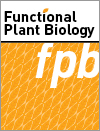This Editorial reflects on the past 50 years of Functional Plant Biology and its future directions.

Functional Plant Biology
Volume 50 Number 3 2023
It is challenging to isolate transmembrane Ca2+ currents that are activated during the generation of action potentials in plants. We applied several different Ca2+ channel blockers (verapamil, tetrandrine, and NED-19). It was found that, while verapamil and NED-19 did affect Ca2+ currents, non-specific effects were also observed, compromising the usage of these blockers as selective means of distinguishing Ca2+ currents in plants.
Pyrene, a toxic polycyclic aromatic hydrocarbon, has detrimental effects on plants. Pyrene inhibits photosynthetic efficiency and decreases biomass of soyabean. Bacillus subtilis (NCIM 5594) in soil overcomes inhibitory effects of pyrene. About 70% degradation of pyrene was achieved in soil using B. subtilis.
After inoculation of fungal pathogens, the plant cells can be stimulated to change their protein phosphorylation levels in response to the fungal chitin. In this study, we performed quantitative phosphoproteomics analysis to study the changes in the plasma membrane after fungal chitin treatment in Arabidopsis thaliana L. Our results may provide new insights into the pathways of chitin-induced plant responses.
FP220476-Benzyladenine alleviates NaCl stress in watermelon (Citrullus lanatus) seedlings by improving photosynthesis and upregulating antioxidant defences
 , Meiling Gao, Yu Guo, Ziwei Zhang, Zhaomin Zhang, Li Chi, Zhongcheng Qu, Lei Wang and Rongyan Huang
, Meiling Gao, Yu Guo, Ziwei Zhang, Zhaomin Zhang, Li Chi, Zhongcheng Qu, Lei Wang and Rongyan Huang
The antioxidant and ascorbate-glutathione cycle of two types of salt-tolerant watermelon (Citrullus lanatus L.) seedlings under NaCl stress reveal an cytokinin regulated watermelon acclimation mechanism to the NaCl stress.
A hydroponic experiment with (8 mmol L−1) and without manganese was established to explore the mechanisms of manganese tolerance of Polygonum lapathifolium Linn via the effects on photosynthesis and metabolism. The results showed that manganese increased plant biomass, photosynthesis, and stomatal conductance. Moreover, among 1022 metabolites, 56 were significantly differentially accumulated, and flavonoids may be the key to the high tolerance of P. lapathifolium. The increased energy and photosynthates from photosynthesis were not allocated to amino acid synthesis.
FP21259Characterisation of internal oxygen concentration of strawberry (Fragaria × ananassa) and blueberry (Vaccinium corymbosum)
 , Stephen D. Tyerman
, Stephen D. Tyerman  , Timothy Stait-Gardner
, Timothy Stait-Gardner  , William S. Price
, William S. Price  , Vinay Pagay
, Vinay Pagay  , Leigh M. Schmidtke
, Leigh M. Schmidtke  and Suzy Y. Rogiers
and Suzy Y. Rogiers 
Understanding the dynamics and factors regulating internal oxygen concentration ([O2]) of strawberry (Fragaria × ananassa Duch.) and blueberry (Vaccinium corymbosum L.) fruit can assist horticultural improvement and post-harvest management. This work has integrated oxygen sensing and non-destructive imaging techniques to provide insight into the 3D microstructure of the mesocarp of strawberries and blueberries. The results provide fundamental knowledge on how oxygen and tissue anatomy are interrelated in small soft fruit. The implications of the observed anatomical features on post-harvest fruit physiology (specifically internal [O2]) are discussed.
FP21259 Abstract | FP21259 Full Text | FP21259PDF (4.1 MB) | FP21259Supplementary Material (2.7 MB) Open Access Article




